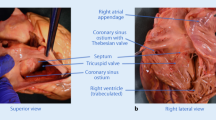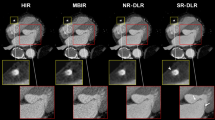Abstract
In order to improve the understanding and interpretation of cine coronary arteriograms obtained in various angled projections, a three-dimensional wire model was constructed. The main coronary arteries and most important muscular branches are simulated by a wire skeleton. The model can be rotated to simulate the standard right and left anterior oblique and left lateral projections. The degree of rotation is indicated on the base of the model. By tilting the model, cephalad and caudad tube angulation can be simulated. By placing the model in front of the cine projector, the shadows of the wires can be superimposed upon the projected cine coronary arteriogram.
This simple, inexpensive model has greatly improved the three-dimensional understanding of the coronary arterial tree in various angled and nonangled views and in our practice had led to the development of additional useful projections.
Similar content being viewed by others
References
Daves ML (1970) Cardiac roentgenology. The loop and circle approach. Radiology 95:157–160
Hood JH (1973) Anatomy of the coronary arteries. Semin Roentgenol 8:3–17
Sos TA, Sniderman KW (1980) A simple method of teaching three-dimensional coronary artery anatomy. Radiology 134:60–606
Bunnell IL, Greene DG, Tandon RN, Arani DT (1973) The half-axial projection: A new look at the proximal left coronary artery. Circulation 48:1151–1156
Arani DT, Bunnell IL, Greene DG (1975) Lordotic right posterior oblique projection of the left coronary artery: A special view for special anatomy. Circulation 52:504–508
Aldridge HE, McLoughlin MJ, Taylor KW (1975) Improved diagnosis in coronary cinearteriography with routine uses of 110° oblique views and cranial and caudal angulations. Am J Cardiol 36:468–473
Lespérance J, Saltiel J, Petitclerc R, Bourassa MG (1974) Angulated views in the sagittal plane for improved accuracy of cinecoronary angiography. AJR 121:565–574
Nath PH, Velasquez G, Castaneda-Zuniga WR, Zollikofer C, Formanek A, Amplatz K (1979) An essential view in coronary arteriography. Circulation 60:101–106
Miller RA, Warkenin DL, Felix WG, Hashemian M, Leighton RF (1980) Angulated views in coronary angiography. AJR 134:407–412
Guthaner DF, Wexler L (1980) New aspects of coronary angiography. Radiol Clin North Am 18:501–514
Paulin S (1981) Terminology for radiographic projections in cardiac angiography (letter). Cathet Cardiovasc Diagn 7:341–344
Elliott LP, Green CE, Rogers WJ, Mantle JA, Papapietro S, Hood WP (1982) The importance of angled right anterior oblique views in improving visualization of the coronary arteries. I: Caudocranial view. Radiology 142:631–636
Elliott LP, Green CE, Rogers WJ, Mantle JA, Papapietro S, Hood WP (1982) The importance of angled right anterior oblique views in improving visualization of the coronary arteries. II: Craniocaudal view. Radiology 142:637–641
Author information
Authors and Affiliations
Rights and permissions
About this article
Cite this article
Coleman, C., Castaneda-Zuniga, W.R. & Amplatz, K. Three-dimensional teaching model for coronary angiography. Cardiovasc Intervent Radiol 5, 154–156 (1982). https://doi.org/10.1007/BF02552302
Issue Date:
DOI: https://doi.org/10.1007/BF02552302




